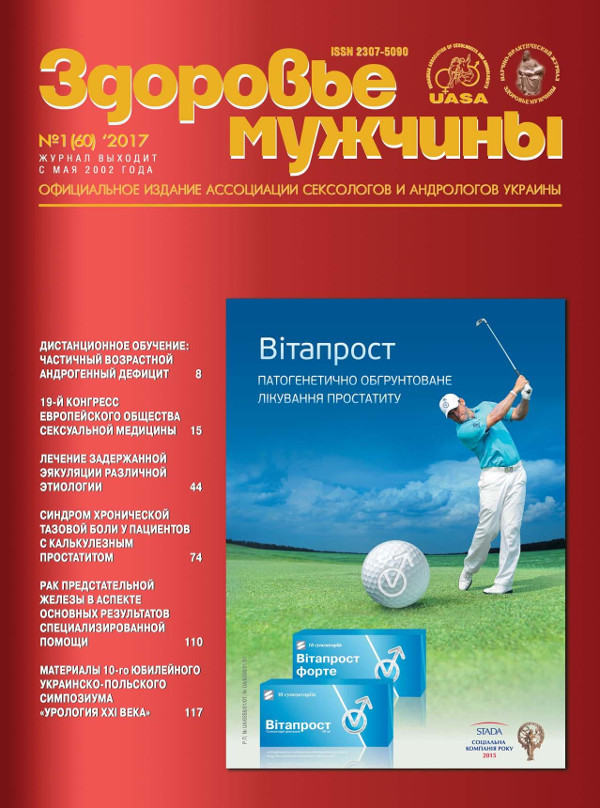Our experience and features of the percutaneous nephrolithotripsy in nephrolithiasis horseshoe kidneys treatment
##plugins.themes.bootstrap3.article.main##
Abstract
According to the results of our study, 34 lithotripsy in 32 patients with staghorn, and multiple large horseshoe kidney stones have been performed. Unusual course was accompanied in 40.6% of cases.
Difficulties in percutaneous surgery of horseshoe kidneys were caused by atypical pyelocaliceal system structure and location, features in anatomical blood supply and negative interaction with the surrounding organs. However, the appropriate knowledge of the anatomical features and technical skills of the surgeon can achieve good efficiency. According to the results of the study, percutaneous nephrolithotripsy in combination with ECHL is 96.9%.
##plugins.themes.bootstrap3.article.details##

This work is licensed under a Creative Commons Attribution 4.0 International License.
Authors retain the copyright and grant the journal the first publication of original scientific articles under the Creative Commons Attribution 4.0 International License, which allows others to distribute work with acknowledgment of authorship and first publication in this journal.
References
Боржієвський А.Ц. Черезшкірна ендоскопічна нефролітотрипсія в лікуванні коралоподібних та великих каменів нирок / А.Ц. Боржієвський // Львів: «Кварт», 2007. – 131 с.
Боржієвський А.Ц. Ефективність ендоскопічного лікування хворих коралоподібним і великим нефролітіазом / Боржієвський Ц.К., Шеремета Р.З. та [ін.] // Acta Medica Leopoliensia. – 2009. – V. 15, No 1. – С. 45–51.
Джавад-Заде М.Д. Хирургия аномалии почек / М.Д. Джавад-Заде, Э.М. Шимкус. – Баку: Азербайджанское государственное издательство, 1977. – 348 с.
Лопаткин Н.А. Аномалии мочеполовой системы / Н.А. Лопаткин, А.В. Люлько. – Киев: «Здоров’я», 1987. – 415 с.
Ухаль М.И. Суперселективная химиоэмболизация сосудов малой опухоли подковообразной почки, как первый этап перед резекцией пораженной опухолью почечной ткани / М.И. Ухаль, А.Н. Кваша, Е.М. Ухаль // Матеріали науково-практичної конференції з міжнародною участю »ОНКО-2012. Протиріччя в діагностиці та лікуванні онкоурологічних захворюваннь», 19 жовтня 2012 року, м. Одеса. – Одеса, 2012. – С. 31–32.
Яненко Э.К. Классификация коралловидного нефролитиаза и алгоритм лечебной тактики / Э.К. Яненко, К.В. Хурцев, Т.И. Макарова // 4-й Всесоюзный съезд урологов: тезисы докладов. – М., 1990. – С. 600–601.
Ghani K.R. Three-dimensional planning of percutaneous renal stone surgery in a horseshoe kidney using 16-slice CT and volume-rendered movies /Rintoul M., Patel U., Anson K. // J. Endourol, 2005. – May; V. 19 (4). – P. 461–463.
Miller N.L. The presence of horseshoe kidney does not affect the outcome of percutaneous nephrolithotomy / Matlaga B.R., Handa S.E. [et al.] // J. Endourol. – 2008. – Jun; V. 22(6). –
P. 1219–1244.
Raj G.V. Percutaneous management of calculi within horseshoe kidneys / B.K. Auge, A.Z. Weizer [et al.] // The J. of Urology. – 2003. – V. 170. – P. 48–51.
Ray A.A. Shockwave lithotripsy in patients with horseshoe kidney: determinants of success / D. Ghiculete, R.J. D’A Honey, K.T. Pace // J. Endourol – 2011. – Mar; V.25(3). – P. 487–580.
Tkocz M.T. The stone of horseshoe kidney – different kind of the treatment / M.T. Tkocz, M.K. Kupajski // European Urology Supplements. – 2011. –V. 10, Issue 9. – P. 639.





